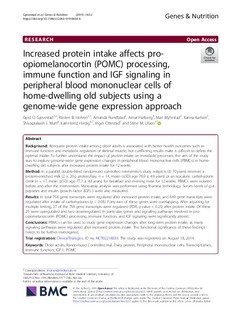| dc.contributor.author | Ulven, Stine Marie | |
| dc.contributor.author | Holven, Kirsten Bjørklund | |
| dc.contributor.author | Rundblad, Amanda | |
| dc.contributor.author | Flatberg, Arnar | |
| dc.contributor.author | Myhrstad, Mari | |
| dc.contributor.author | Karlsen, Karina | |
| dc.contributor.author | Mutt, Shivaprakash | |
| dc.contributor.author | Herzig, Karl-Heinz | |
| dc.contributor.author | Ottestad, Inger | |
| dc.contributor.author | Gjevestad, Gyrd Omholt | |
| dc.date.accessioned | 2020-02-10T15:42:13Z | |
| dc.date.available | 2020-02-10T15:42:13Z | |
| dc.date.created | 2020-01-28T09:17:38Z | |
| dc.date.issued | 2019 | |
| dc.identifier.citation | Genes & Nutrition. 2019, 14 (32), . | nb_NO |
| dc.identifier.issn | 1555-8932 | |
| dc.identifier.uri | http://hdl.handle.net/11250/2640877 | |
| dc.description.abstract | Background
Adequate protein intake among older adults is associated with better health outcomes such as immune function and metabolic regulation of skeletal muscle, but conflicting results make it difficult to define the optimal intake. To further understand the impact of protein intake on metabolic processes, the aim of the study was to explore genome-wide gene expression changes in peripheral blood mononuclear cells (PBMCs) in home-dwelling old subjects after increased protein intake for 12 weeks.
Method
In a parallel double-blind randomized controlled intervention study, subjects (≥ 70 years) received a protein-enriched milk (2 × 20 g protein/day, n = 14, mean (±SD) age 76.9 ± 4.9 years) or an isocaloric carbohydrate drink (n = 17, mean (±SD) age 77.7 ± 4.8 years) for breakfast and evening meal for 12 weeks. PBMCs were isolated before and after the intervention. Microarray analysis was performed using Illumina technology. Serum levels of gut peptides and insulin growth factor (IGF)-1 were also measured.
Results
In total 758 gene transcripts were regulated after increased protein intake, and 649 gene transcripts were regulated after intake of carbohydrates (p < 0.05). Forty-two of these genes were overlapping. After adjusting for multiple testing, 27 of the 758 gene transcripts were regulated (FDR, q-value < 0.25) after protein intake. Of these 25 were upregulated and two downregulated. In particular, genes and signaling pathways involved in pro-opiomelanocortin (POMC) processing, immune function, and IGF signaling were significantly altered.
Conclusions
PBMCs can be used to study gene expression changes after long-term protein intake, as many signaling pathways were regulated after increased protein intake. The functional significance of these findings needs to be further investigated. | nb_NO |
| dc.language.iso | eng | nb_NO |
| dc.publisher | Springer Verlag | nb_NO |
| dc.rights | Navngivelse 4.0 Internasjonal | * |
| dc.rights.uri | http://creativecommons.org/licenses/by/4.0/deed.no | * |
| dc.title | The effect of increased protein intake on genome-wide gene expression in peripheral mononuclear cells of home-dwelling old subjects | nb_NO |
| dc.type | Journal article | nb_NO |
| dc.type | Peer reviewed | nb_NO |
| dc.description.version | publishedVersion | nb_NO |
| dc.source.pagenumber | 12 | nb_NO |
| dc.source.volume | 14 | nb_NO |
| dc.source.journal | Genes & Nutrition | nb_NO |
| dc.source.issue | 32 | nb_NO |
| dc.identifier.doi | 10.1186/s12263-019-0654-6. | |
| dc.identifier.cristin | 1783684 | |
| dc.description.localcode | © The Author(s). 2019 Open Access This article is distributed under the terms of the Creative Commons Attribution 4.0 International License (http://creativecommons.org/licenses/by/4.0/) | nb_NO |
| cristin.unitcode | 194,65,15,0 | |
| cristin.unitname | Institutt for klinisk og molekylær medisin | |
| cristin.ispublished | true | |
| cristin.fulltext | postprint | |
| cristin.qualitycode | 1 | |

